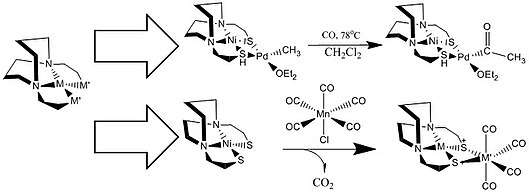Marcetta Y. Darensbourg
Marcetta York Darensbourg is an American inorganic chemist. She is a Distinguished Professor of Chemistry at Texas A&M University. Her current work focuses on iron hydrogenases and iron nitrosyl complexes.
Education
Darensbourg received a B.S. in Chemistry from Union College in 1963, and a Ph.D. in inorganic chemistry from the University of Illinois under the guidance of Theodore L. Brown in 1967.[1] Her doctoral work focused on the kinetic studies of organolithium reactions.
Career
Darensbourg was an assistant professor at Vassar College from 1967–1969. From 1971–1982, she taught at Tulane University, attaining the rank of professor. In 1982, Marcetta Darensbourg was appointed professor at Texas A&M University together with Donald J. Darensbourg. She was subsequently awarded the title of Distinguished Professor in 2010.[2] Her research interests include bimetallic hydrogenase enzymes containing CO and CN ligands.
Darensbourg sits on the board of Inorganic Syntheses,[3] where she also served as the editor-in-chief of volume 32.[4] In 2011, she was elected fellow of the American Academy of Arts and Sciences.[5]
Research projects
Organolithium chemistry
Darensbourg investigated certain kinetic aspects of organolithium compounds. During the course of these studies, the kinetics of the rate-determining step of tert-butyllithium dissociation from tetramer to a dimer were analyzed.[6] Using mass spectroscopy, the existence of cross-association with other organolithium species in the vapor phase could also be observed.[6]

Metal carbonyl chemistry
Darensbourg's interest in charge distribution molecules that could be probed with reactivity led to her work on mapping nucleophilic attack on metal carbonyls. Infrared, nuclear magnetic resonance and electronic spectroscopy of some carbene pentacarbonyl complexes of chromium(0) and tungsten(0) indicated that carbene ligands are better sigma donors than a carbonyl ligand, while simultaneously behaving as strong pi acceptors.[7] Substitutions of iron and cobalt sites were made to see how the CO strength force constants affected the nucleophilic attacks. The substitutions illustrated that the nucleophilic attacks always occurred at the CO group with the greater force constant when there is a choice of carbonyl groups present in a molecule.[8]
Hydrogenase mimics
Darensbourg has pioneered the development of synthetic mimics of hydrogenase enzymes. These include synthetic complexes featuring Fe-based organometallics species, which serve as precursor for producing iron only Hydrogenase enzyme active site. These enzymes are capable of carry out reaction even in the absence of the protein-based active site organization[9] or carry out the proton production with high efficiencies. However, these hydrogenase enzymes were found to be highly sensitive with oxygen (O2), which can over oxidize and inactivate them. Even after the oxygen was removed, they do not regain catalytic activity immediately, requiring multiple steps to do so.[10]
Metallodithiolates chemistry

In the beginning of 2017, Darensbourg shifted her focus to studying the metallodithiolates ligands, which act as building blocks for the synthesis of various bimetallic enzyme active sites. The ligands can act as a catalyst to carry out different reactions, depending on which transition metal being at the center.[11]
Darensbourg et al. reported that metallodithiolates ligands with nickel centers can increase the electron density of bonds such as Fe-S, allowing them to be cleaved easily.[12] Darensbourg et al. also determined that this nickel center complex associated with a lead atom also plays an important role in the addition of CO and ethylene in the Suzuki-Miyaura reaction, which couples the organic compounds of boron and the halides, along alkyl halides and alkylboranes.[13] Furthermore, with the cCobalt center, the metallodithiolates ligands can catalyze the transfer of NO and nitrosylate moieties, which allows the glycosidase conjugation of dinitrosyl iron complexes. With this conjugation, other carbohydrates can achieve higher potential in attaching for drug delivery.[6]
References
- "Marcetta Y. Darensbourg". Texas A&M University.
- "Five Science Faculty Honored as Distinguished Professors" (Press release). Texas A&M University. 6 Sep 2010. Archived from the original on 28 September 2011. Retrieved 18 July 2011.
- "The Inorganic Syntheses Organization". Inorganic Syntheses. Archived from the original on 2011-07-13.
- "Recent Volumes". Inorganic Syntheses. Archived from the original on 2011-07-13.
- "Darensbourg Elected Fellow of American Academy of Arts and Sciences" (Press release). Texas A&M University. 19 Apr 2011.
- Kimura, Bert Y.; Hartwell, George E.; Lawrence, Theodore; Darensbourg, Marcetta Y. (1970). "Organometallic Exchange Reactions. X. Cross-association of Tert Butyllithium. Kinetics of Tert Butyllithium Dissociation". Journal of the American Chemical Society. 92 (5): 1236–242. doi:10.1021/ja00708a022.
- Darensbourg, Marcetta Y.; Darensbourg, Donald J. (1970). "Spectroscopic Studies of Some Carbene Pentacarbonyl Complexes of Chromium(0) and Tungsten(0)". Inorganic Chemistry. 9 (1): 32–39. doi:10.1021/ic50083a007.
- Darensbourg, Donald J.; Darensbourg, Marcetta Y. (1970). "Reactions of Transition Metal Carbonyls with Organolithium Compounds. II. Prediction of Nucleophilic Attack at Carbon and Resultant Stereochemistry". Inorganic Chemistry. 9 (7): 1691–694. doi:10.1021/ic50089a016.
- Lyon, Erica J; Zhao, Xuan; Georgakaki, Irene P.; Darensbourg, Marcetta Y. (2003). "The Organometallic Active Site of [Fe]hydrogenase: Models and Entatic States". Proceedings of the National Academy of Sciences of the United States of America. 100 (7): 3683–3688. Bibcode:2003PNAS..100.3683D. doi:10.1073/pnas.0536955100. PMC 152982. PMID 12642671.
- Tye, Jesse W.; Hall, Michael B.; Darensbourg, Marcetta Y. (2005). "Better than Platinum? Fuel Cells Energized by Enzymes". Proceedings of the National Academy of Sciences of the United States of America. 102 (47): 16911–16912. Bibcode:2005PNAS..10216911T. doi:10.1073/pnas.0508740102. PMC 1288019. PMID 16286638.
- Pulukkody, Randara; Chupik, Rachel B.; Montalvo, Steven K.; Khan, Sarosh; Bhuvanesh, Nattamai; Lim, Soon-Mi; Darensbourg, Marcetta Y. (2017). "Toward Biocompatible Dinitrosyl Iron Complexes: Sugar-Appended Thiolates". Chemical Communications. 53: 1180–1183. doi:10.1039/c6cc08659d.
- Tiankun, Zhao; Ghosh, Pokhraj; Martinez, Zachary; Liu, Xufeng; Meng, Xianggao; Darensbourg, Marcetta Y. (2017). "Discrete Air-Stable Nickel(II)-Palladium(II) Complexes as Catalysts for Suzuki-Miyaura Reaction". Organometallics. 36 (9): 1822–1827. doi:10.1021/acs.organomet.7b00176.
- Ghosh, Pokhraj; Quiroz, Manuel; Wang, Ning; Bhuvanesh, Nattamai; Darensbourg, Marcetta Y. (2017). "Complex of as platform for exploring cooperative heterobimetallic effects in HER electro catalysis". Dalton Transactions. 46: 5617–5624. doi:10.1039/c6dt04666e.